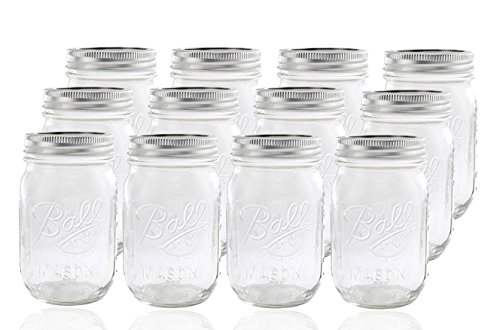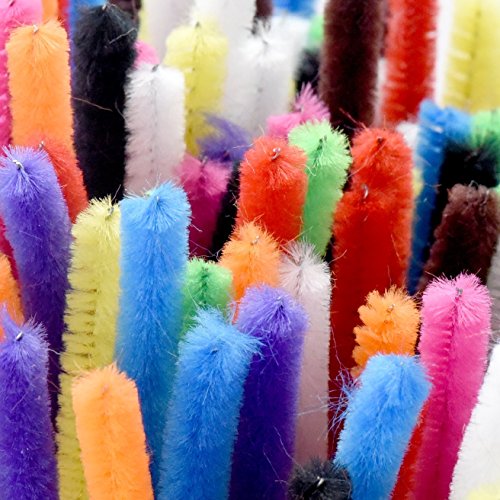It’s no secret that we’re really into salt crystals. We love making salt crystals as one of our crystal experiments, because they are easy, take just a little while to make, and they illustrate so many fun scientific principles! When you make crystal Easter eggs, you can learn about salt molecules, ionic bonds, evaporation, molecule attraction, and the chemical properties of salt and water.
If you want to transform this science experiment into a STEAM project, hang your salt crystal eggs from a window or on an Easter tree!
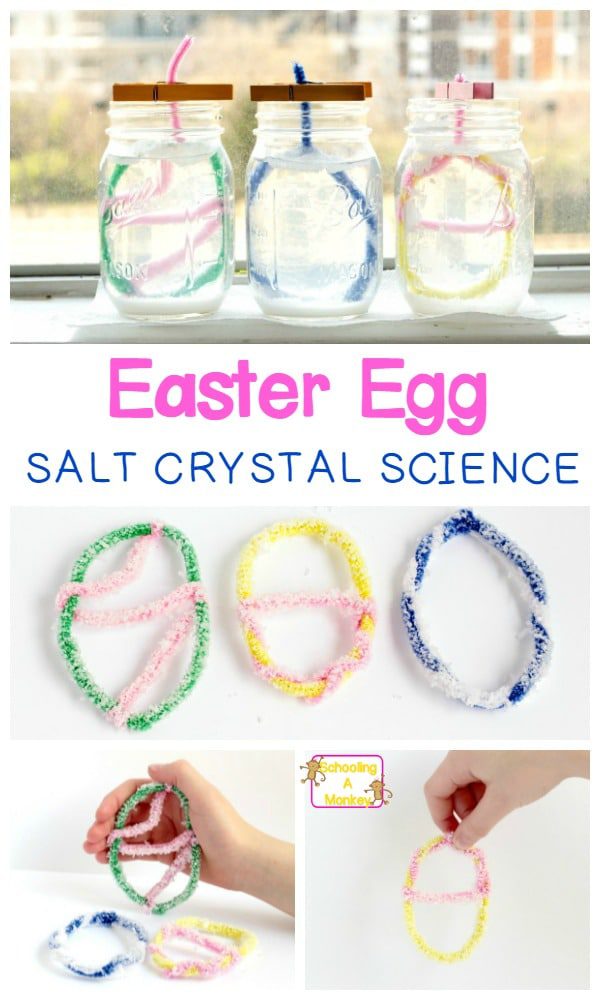
My kids absolutely loved this experiment and it was so much fun watching the eggs get coated in a layer of sparkly, square salt crystals.
How to Make Crystal Easter Eggs
Find out how to make your egg salt crystal science project right here!
There is a lot going on behind this super easy science experiment! For Easter, we decided to try the egg crystals science project to round out our Easter STEM activities!
What is a Egg Crystals Science Project?
Science experiments can get a bit boring if you do them over and over again. But if you bring in seasonal elements for each holiday, then even common science experiments become fresh again.
With the egg crystals science project, kids are learning scientific concepts and expanding their knowledge of science, but the use of Easter themes keeps these experiments fresh and fun.
We really like making salt crystals and crystals in general because you can teach a lot of scientific concepts in one activity!
We like to repeat crystal making over and over and focus on something new each time scientifically!
Why Make Easter Egg Crystals?
I like to do Easter science experiments because my kids love using seasonal themes in their science experiments.
Why just make regular salt crystals when you can make pretty Easter egg salt crystals?
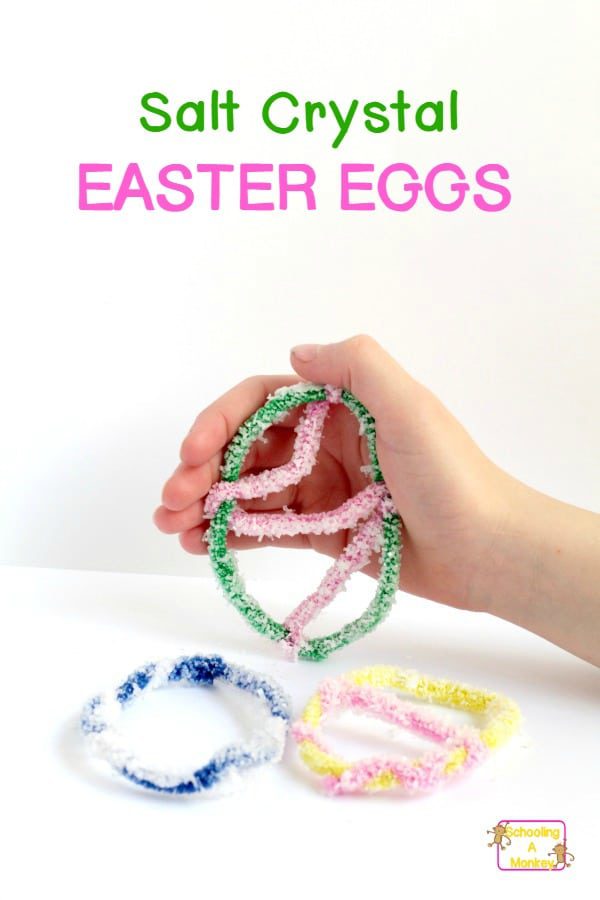
Kids will have a blast discovering how scientific principles, concepts, and experiments can be illustrated to match every season and holiday of the year.
You certainly don’t have to do Easter science experiments, but it’s a lot of fun if you do!
Salt Crystal Science
When you make salt crystal Easter eggs, kids can learn a lot!
With a single salt crystal, you can learn about salt molecules, ionic bonds, evaporation, molecule attraction, and the chemical properties of salt and water.
There is a lot you can learn by making Easter egg salt crystals!
Salt Crystal STEAM Elements
Science: Use this project to teach evaporation, water saturation, density, chemical bonds, molecules, and chemistry.
Technology: It takes technology to boil water! Imagine how hard this project would be if you had to boil the water over a campfire.
Engineering: Kids will need to determine how much salt to use for their projects and what design to make their eggs. The more additions an egg has, the more crystals it will attract!
Art: The completed eggs make pretty decorations.
Math: Measuring and temperature measurement are used in this project.
More Fun Easter Science Experiments to Try!
Super Fun and Easy Crystal Science Fair Projects
If you like these Easter egg salt crystals, check out our list of:
- Easter STEM activities
- Easter science activities for preschool
- easter science experiments for kindergarten
- Easter science activities for elementary
- Easter STEAM activities
- Easter science projects for middle school
And you’ll also love these Peeps candy science experiments and Peeps STEAM activities.
How to Do the Crystal Egg Experiment
These salt crystal Easter eggs are a cinch to make, but they are the perfect bridge between science and the Easter holiday.
Learn how to make them right here!
What you’ll need to make salt crystal Easter eggs:
This post contains affiliate links for your convenience.
12 Ball Mason Jar with Lid – Regular Mouth – 16 oz by JardenMorton Salt Regular Salt, 26 Oz, Pack of 2
CHENILLE STICKS PIPE CLEANERS for Craft 100pcs Set by Colorona – Extra Long Reusable Chenille Wire Stem – Bendable & Twistable Summer Art Pipes – Kids Safe – Assorted Colors (12 Inches) 2017 Edition
Home-X Wooden Clothespins. Set of 50.
- Pipe cleaners (2 per egg)
- Mason jars (1 jar for each egg)
- Salt (1 regular-sized container per 4 eggs)
- Clothespins
- A way to heat water
- Magnifying glass
- Scissors
How to Do the Egg Crystals Experiment
First, boil enough water for all your mason jars. Our jars could hold two cups of water each, so we heated six cups.
Once the water boils, add in your salt. It takes about 1 cup of salt for each salt crystal egg.
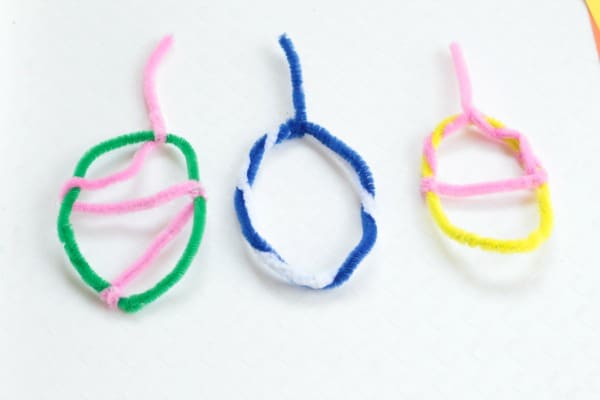
You probably can get the crystals to form with less salt (another good idea for a science project!), but they form a lot faster with over-saturated water.
When the salt starts to form a crystal on top of the water, you’ve added enough. Pour the water into jars.
Let the kids form egg shapes with the pipe cleaners. We used two pipe cleaners for each egg.
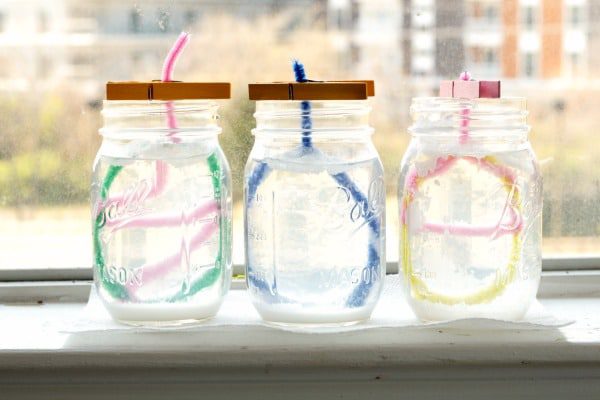
This gave us enough to make the egg shape and leave a bit left over to suspend the eggs in the saltwater solution.
Use a clothespin to suspend the eggs inside each jar so that the eggs don’t touch the side or bottom of the jar.
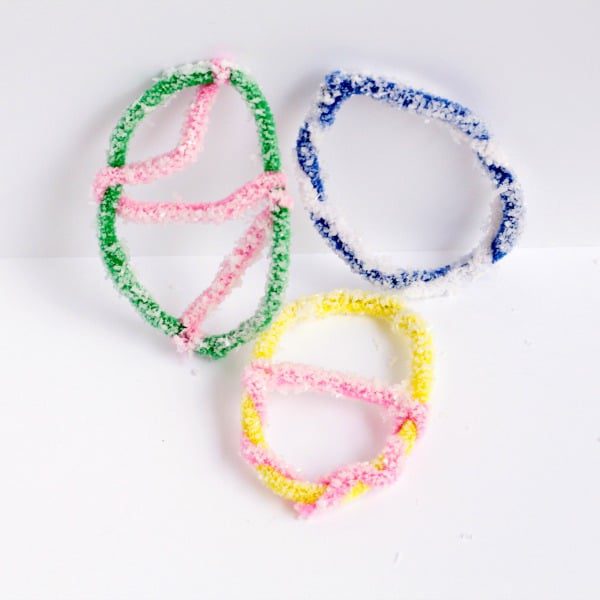
Wait about 2-3 days for crystals to form. The longer you wait, the bigger the crystals will be!
Remove the eggs from the jars and trim the hanger with scissors. Dry the eggs on a paper towel. Don’t let the salt crystals get too wet or they will melt again.
When the eggs are dry, use a magnifying glass to inspect the crystals.
My kids are always impressed at the rectangle shapes that salt crystals always make!
If you do this experiment, we’d love to see it! Share your experiment on social media with #STEAMsational and let the world see your creations!

